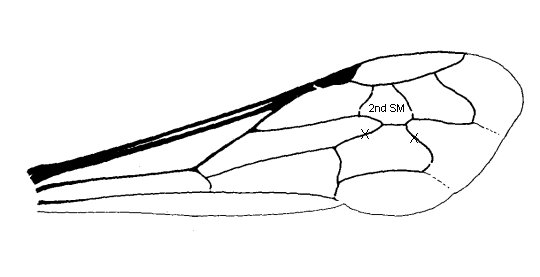|
Key to the Tribes of Sphecid Wasps in Arkansas
This key is modified from the key in the volume Sphecid Wasps of the World from Bohart and Menke. It includes only the tribes predicted for occurrence in Arkansas. By no means have these all been proven in the state. Predicted genera for each tribe and the species number expected are included below the tribes. This will be refined as we find or fail to find species. Keys to the genera in each tribe are being added. Click on the tribe name to go to genera keys. Click on linked terms to access Wasp Terminology images (use back button from there to return to same spot on main key). Images are also from the Bohart and Menke text. Those coyrights are held by those authors and California Press. Eastern Sphecid Wasp list.
1. Gaster with a cylindrical petiole composed of sternum only, tergum I removed to apex of sternum I, jugal lobe of hindwing comprising nearly all of anal area 2 1. Gaster without a petiole composed of sternum only, or if so, jugal lobe of hindwing comprising at most not much more than half of anal area 4
2. Tarsal claws of foreleg and midleg with two or more basal teeth along inner margin
Tribe Sphecini Isodontia (4) Sphex (4) Palmodes (1) Prionyx (3) 2. Tarsal claws of foreleg and midleg simple or each with a single tooth on inner margin 3
3. Tarsal claws simple or rarely with a basal tooth Tribe Ammophilini Podalonia (4) Eremnophila (1) Ammophila (12) 3. Tarsal claws with one mesal tooth Tribe Sceliphronini Chalybion (2) Chlorion (1) Podium (2) Sceliphron (1) 4. Midtibia with two apical spurs (rarely none) 5 4. Midtibia with one apical spur (rarely none) 11
5. Claws with one inner tooth or bifid
Gaster petiolate Tribe Ampulicini Ampulex (1) Gaster sessile Tribe Dolichurini Dolichurus (1) 5. Claws simple or with a basal lobe, not a tooth 6
6. Hindwing jugal lobe more than half the length of anal area
Tribe Astatini Astata (5) Dryudella (1) 6. Hindwing jugal lobe less than half the length of anal area
7
7. Forewing with prestigmal length of first submarginal cell much more than length of wing beyond marginal cell
Tribe Stizini (part) Bembecinus (1) Stizus (1) Stizoides (1)
7. Forewing with prestigmal length of first submarginal cell not distinctly more than length or wing beyond marginal cell or propodeum with a lateral tooth or prong 8
8. Pronotal collar low, longer than scutellum in dorsal view Tribe Alyssonini (part) Didineis (2) 8. Pronotal collar shorter than scutellum in dorsal view 9
9. Admedian scutal lines fused to form a single furrow, propodeum with a lateral tooth or prong Tribe Nyssonini Hyponysson (1) Nysson (7) Synnevrus (2) Epinysson (3) Zanysson (2) 9. Admedian scutal lines well separated, propodeum not toothed or pronged 10
10. Second submarginal cell of forewing receiving at least the second recurrent vein
Tribe Gorytini Ochleroptera (1) Argogorytes (1) Gorytes (5) Pseudoplisus (5) Oryttus (1) Psammaletes (1) Sphecius (2) Tanyoprymnus (1) Hoplisoides (5)
10. Second submarginal cell of forewing receiving at most the first recurrent vein Tribe Mellinini Mellinus (1)
11. Gaster with petiole composed of sternum only, tergum I removed to distal end of sternum 12 11. Gaster not petiolate, or petiole composed of both tergum and sternum 13
12. Forewing with three submarginal cells Tribe Psenini Mimumesa (2) Mimesa (4) Pseneo (2) Psen (1) Pluto (1) Psenulus (1)
12. Forewing with no more than two submarginal cells Tribe Pemphredonini (part) Pemphredon (2) Cemonus (3) Passaloecus (3) Stigmus (3) Spilomena (3) Xysma (1)
13. Forewing either with one discoidal cell, at most two submarginal cells, and a much enlarged stigma or two to three submarginal cells, stigma nearly as large as first discoidal cell, two sessile submarginal cells, mandible simple externoventrally, inner orbits not angulate, and hindwing media diverging at or before cu-a Tribe Pemphredonini (part) See genera above 13. Without either combination above 14
14. Hindocelli deformed or greatly reduced 15 14. Hindocelli normal 16
15. Hindwing jugal lobe subequal to length of anal area Tribe Larrini Larra (1) Liris (1) Larropsis (7) Ancistromma (3) Tachytes (15) Tachysphex (13)
15. Hindwing jugal lobe at most a little more than half as long as anal area Tribe Bembecini Bicyrtes (5) Microbembex (1) Stictia (1) Bembix (8) Stictiella (2) Glenostictia (1)
16. Propodeum with a small, sharp dorsal tooth posterolaterally Tribe Alyssonini (part) Alysson (7) 16. Propodeum not distinctly toothed 17
17. Antennal sockets placed above clypeus by at least one-third of a socket diameter, forewing with three submarginal cells 18 17. Antennal sockets touching clypeus, or if not, then forewing with fewer than three submarginal cells 20
18. Hindfemur ending in a flattened plate or truncation
Tribe Cercerini Cercerus (25) 18. Hindfemur ending normally 19
19. Inner orbits angulate
Tribe Philanthini Philanthus (6)
19. Inner orbits straight or smoothly curved
Tribe Aphilanthopsini Aphilanthops (2) Clypeadon (1)
20. Inner orbits angulate, often only one submarginal cell in forewing Tribe Trypoxylonini Trypoxylon (14) 20. Inner orbits not angulate 21
21. Forewing with more than one submarginal cell, or more than two discoidal cells, or both (subdiscoidal cell counted as discoidal cell) 22 21. Forewing with one submarginal cell and one or two discoidal cells 23
22. Inner orbits converging strongly below
Tribe Bothynotstethini Bothynostethus (1)
22. Inner orbits not converging strongly below
Tribe Miscophini Lyroda (2) Plenoculus (1) Solierella (4) Miscophus (1)
23. Forewing with two well defined discoidal cells in addition to the submarginal cell Tribe Crabronini Anacrabro (1) Entomognathus (3) Lindenius (3) Rhopalum (4) Moniaecera (1) Crossocerus (13) Crabro (15) Enoplolindenius (1) Ectemnius (16) Lestica (2)
23. Forewing with only one discoidal cell Tribe Oxybelini Belomicrus (1) Oxybelus (15)
|










